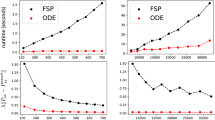Abstract
The master equation of chemical reactions is solved by first approximating it by the Fokker–Planck equation. Then this equation is discretized in the state space and time by a finite volume method. The difference between the solution of the master equation and the discretized Fokker–Planck equation is analyzed. The solution of the Fokker–Planck equation is compared to the solution of the master equation obtained with Gillespie’s Stochastic Simulation Algorithm (SSA) for problems of interest in the regulation of cell processes. The time dependent and steady state solutions are computed and for equal accuracy in the solutions, the Fokker–Planck approach is more efficient than SSA for low dimensional problems and high accuracy.
Similar content being viewed by others
References
Aronson D.G., Serrin J. (1967) Local behavior of solutions of quasilinear parabolic equations. Arch. Rat. Mech. Anal. 25, 81–122
Benzer S. (1953) Induced synthesis of enzymes in bacteria analyzed at the cellular level. Biochim. Biophys. Acta 11, 383–395
Berg O.G. (1978) A model for the statistical fluctuations of protein numbers in a microbial population. J. Theor. Biol. 71, 587–603
Berg O.G. (1978) On diffusion-controlled dissociation. J. Chem. Phys. 31, 47–57
Cao Y., Gillespie D., Petzold L. (2005) Multiscale stochastic simulation algorithm with stochastic partial equilibrium assumption for chemically reacting systems. J. Comput. Phys. 206, 395–411
Dieudonné J. (1969). Foundations of modern analysis, Academic, New York
Elf J., Berg O.G., Ehrenberg M. (2001) Comparison of repressor and transcriptional attenuator systems for control of amino acid biosynthetic operons. J. Mol. Biol. 313, 941–954
Elf J., Paulsson J., Berg O.G., Ehrenberg M. (2003) Near-critical phenomena in intracellular metabolite pools. Biophys. J. 84, 154–170
Elowitz M.B., Surette M.G., Wolf P.-E., Stock J.B., Leibler S. (1999) Protein mobility in the cytoplasm of Escherichia coli. J. Bacteriol. 181, 197–203
Érdi P., Tóth J. (1988) Mathematical models of chemical reactions. Princeton University Press, Princeton
Ferm, L., Lötstedt, P., Sjöberg, P.: Conservative solution of the Fokker–Planck equation for stochastic chemical reactions. BIT (in press, 2006)
Fersht A. (1998) Structure and mechanism in protein science: a guide to enzyme catalysis and protein folding. W. H. Freeman & Co, New York
Gardiner C.W. (1985) Handbook of stochastic methods. Springer, Berlin Heidelberg New York
Gardner T.S., Cantor C.R., Collins J.J. (2000) Construction of a genetic toggle switch in Escherichia coli. Nature 403, 339–342
Gilbarg D., Trudinger N.S. (1977) Elliptic partial differential equations of second order. Springer, Berlin Heidelberg New York
Gillespie D.T. (1976) A general method for numerically simulating the stochastic time evolution of coupled chemical reactions. J. Comput. Phys. 22, 403–434
Greenbaum A. (1997) Iterative methods for solving linear systems. SIAM, Philadelphia
Hairer E., Nørsett S.P., Wanner G. (1993) Solving ordinary differential equations, nonstiff problems. 2nd edn., Springer, Berlin Heidelberg New York
Haseltine E.L., Rawlings J.B. (2002) Approximate simulation of coupled fast and slow reactions for stochastic chemical kinetics. J. Chem. Phys. 117, 6959–6969
John F. (1980) Partial differential equations. 3rd edn., Springer, Berlin Heidelberg New York
Kærn M., Elston T.C., Blake W.J., Collins J.J. (2005) Stochasticity in gene expression: from theories to phenotypes. Nat. Rev. Genet. 6, 451–464
van Kampen N.G. (1992) Stochastic processes in physics and chemistry. Elsevier, Amsterdam
Larsen R.J., Marx M.L. (1986) An introduction to mathematical statistics and its applications. 2nd edn., Prentice-Hall, Englewood Cliffs
Lehoucq R.B., Sorensen D.C., Yang C. (1998) ARPACK users’ guide: solution of large-scale eigenvalue problems with implicitly restarted Arnoldi methods. SIAM, Philadelphia
Lötstedt P., Söderberg S., Ramage A., Hemmingsson-Frändén L. (2002) Implicit solution of hyperbolic equations with space-time adaptivity. BIT 42, 134–158
MATLAB: The MathWorks, Inc., Natick, MA, USA, http://www.mathworks.com
Novick A., Weiner M. (1957) Enzyme induction as an all-or-none phenomenon. Proc. Natl. Acad. Sci. USA 43, 553–566
Sleijpen G.L.G., van der Vorst H.A. (1996) A Jacobi-Davidson iteration method for linear eigenvalue problems. SIAM J. Matrix Anal. Appl. 17, 401–425
van der Vorst H.A. (1992) Bi-CGSTAB: A fast and smoothly converging variant of Bi-CG for the solution of nonsymmetric linear systems. SIAM J. Sci. Stat. Comput. 13, 631–644
Xie X.S. (2002) Single-molecule approach to dispersed kinetics and dynamic disorder: Probing conformational fluctuation and enzymatic dynamics. J. Chem. Phys. 117, 11024–11032
Author information
Authors and Affiliations
Corresponding author
Additional information
Communicated by G. Wittum.
Rights and permissions
About this article
Cite this article
Sjöberg, P., Lötstedt, P. & Elf, J. Fokker–Planck approximation of the master equation in molecular biology. Comput. Visual Sci. 12, 37–50 (2009). https://doi.org/10.1007/s00791-006-0045-6
Received:
Accepted:
Published:
Issue Date:
DOI: https://doi.org/10.1007/s00791-006-0045-6




